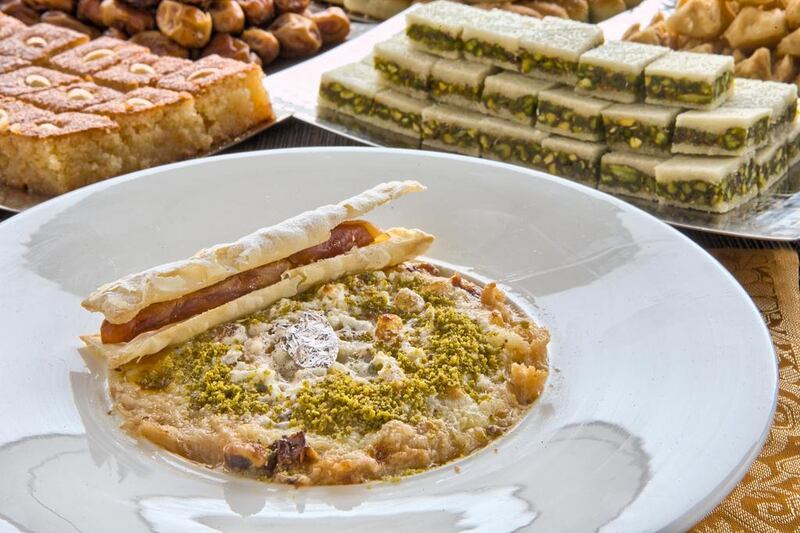Umm Ali
The ingredients list is simple – at its most basic, Umm Ali calls for only stale bread, milk and a few almonds and raisins – yet the origins of this humble dessert are colourful and hotly contested.
The consensus is that the dish was created in Egypt by a woman called Umm Ali (mother of Ali) – but that is where agreement ends and myriad differing stories and claims emerge.
Some say Umm Ali was a thrifty chef working in the kitchens of the palace of Cairo during the Mamluk period. Instead of discarding scraps of food left over from royal feasts, this legend suggests that Umm Ali set them aside for her family.
The palace came under siege, and with food supplies low and the sultan hungry, she was forced to prepare for him a dessert concocted from these stashed odds and ends – dry bread, fruit and milk. Much to her surprise, when she presented it to him he loved the dish and continued to request it, even after the siege during times of prosperity.
A different story, again involving a peckish sultan, tells of another averted disaster. While out hunting, the ruler and his party happened upon a small village and demanded food. Luckily, Umm Ali, the best cook in the hamlet, was able to cobble together a few odd and ends and make a delicious dessert ultimately deemed fit for a sultan.
Other more dramatic anecdotes position Umm Ali as the crafty first wife of Ezz El-Din Aybek, the ruler of an Egyptian dynasty. Following her husband’s death, she became engaged in a vicious dispute with his second wife as to whose son would ascend the throne.
By bribing the second wife’s servants, a vengeful Umm Ali arranged for her rival to be murdered, and celebrated by making a milk-based dessert that she distributed throughout Egypt.
Whichever version of the story you favour – and there are numerous other variations – Umm Ali reigns supreme as Egypt’s most famous dessert and is enjoyed at iftars across the Middle East.
Despite its humble origins, the dish has taken on an altogether more indulgent edge over time. Nowadays, rich double cream is often used instead of milk, and layers of buttery puff pastry replace the stale bread. The fruit, sugar and crunchy nut filling is altogether more abundant. Combined with a hint of spice, from a sprinkling of cinnamon, and a taste of the exotic, courtesy of a little desiccated coconut, it makes for an irresistible pudding.
Although Umm Ali features on most restaurant iftar menus, this is one dish that really is well worth making at home: like all the very best recipes, the preparation is extremely simple, yet the end result is almost otherworldly.
Kallaj Ramadan
Lebanese-born Ali Ammar is head chef at the Arabic-style open-air food bazaar and majilis, Qasr Al Sultan, located between Abu Dhabi and Dubai, near the Outlet Village.
As you might expect from someone of his profession, he places great importance on the food served at iftars. And yet despite his culinary training and experience working in restaurants all over the world, Ammar says during Ramadan his craving for sweet treats is best sated by a selection of Lebanese desserts.
These will certainly include kunafa (strands of filo pastry layered with cheese) and katayef, small, Arabic-style pancakes filled with cream, sweetened akawi cheese or sugared nuts.
However, Kellaj Ramadan is perhaps the dessert most eagerly anticipated by Ammar and many others. As the name suggests, in many places it is only made during the holy month.
For this dish, thin layers of pastry are filled with ashta, a cream similar in texture to British clotted cream that is made by boiling semolina, milk, sugar, corn flour, rosewater and orange-blossom water until it gets thick.
Once cooled, spoonfuls of the cream are piled into the middle of thin sheets of pastry, which are folded and sealed to form a parcel.
After being fried, the kallaj are drizzled generously with an aromatic orange blossom or rose water-infused syrup and topped with finely ground pistachios and slithers of candied orange.
In Lebanon it is common for astute sweet-shop owners to set up kallaj-frying stations outside the shop door, allowing the perfumed aroma of the freshly cooked pastries to lure in hungry customers.
This is, Ammar confirms, a clever tactic: kallaj is at its very best when prepared just before iftar and eaten immediately, while the filling is still warm and the pastry crisp, golden and gleaming with syrup.
artslife@thenational.ae






